You Are Here: Greyghost > Features Page > Hotronic AR-31 / PC-TBC Information Page
Hotronic PC-TBC and AR-31 Information Page
Before
I get started with this particular page, I'd like to take a moment to
tell anyone happening by this page who has plans to purchase any
Hotronic product that they absolutely should not do so.
It's bad enough (though common and
accepted) when a company making consumer grade products refuses to
provide any support at all, much less actual technical material for
products they've sold. It is completely inexcusable in the realm of
professional grade products. I acquired a Hotronic AR-31 Time Base
Corrector and soon found myself with questions concerning its
operation. At least two separate e-mails from different accounts went
completely unanswered by Hotronic.
It's even more insulting when the very first page on their web site clearly says "Please do not hesitate to contact us. We are glad to answer any of your questions." Yeah, right. I hate to slag on any company in public, yet it was apparently too hard for them to say that they couldn't help.
UPDATE! (March 2018) After this
page spent a few years online, I was contacted by John Schmuhl with an
offer to digitize his PC-TBC/AR-31 owner's manual. Mr. Schmuhl kindly
digitized the manual for his PC-TBC, and sent it to me so I could make
it available here. He also sent me a picture of a video transfer system
used to transfer half-inch open-reel EIAJ videotapes to the S-VHS
format. You can see that here, along with another picture of his AR-31 TBC unit. The manual weighs in at just over 3 megabytes in size and can be found right here. I am still very much interested in hearing from anyone with more information about Hotronic or its products. If that's you, please feel free to send me an e-mail!
Meanwhile, I would sincerely like to thank Mr. Schmuhl yet again for
going to the trouble of scanning his manual and sending the result my
way.
In case you're not sure you should be here, this page isn't about foot warmers
or similar products! I have no affiliation with the Hotronic company
and nothing presented here is authorized or endorsed by them in any way.
General Information (what little I have)
Internally, the AR-31 TBC is nothing
more than a PC-TBC card installed in a cabinet with its own power
supply. Although the needed slot bracket is missing, there is nothing
to stop you from installing the TBC board into a personal computer with
ISA slots. (You would need to disconnect the wiring from the power supply in the AR-31 enclosure.)
Here are the product information (not much!) and specification pages for the PC-TBC product.
I also went ahead and grabbed the same for the AR-31: product information and specifications.
Operations
For all the details, check out the downloadable manual, linked above. Both the AR-31 and PC-TBC
products offer controls governing their operation and quite possibly
video signal routing. These controls are accessed through a "remote
panel" that Hotronic claims to be "optional". I don't know if the
PC-TBC board can be controlled through software. Its ISA connector
appears to be used only as a power tap from the host computer. As I'd
have a hard time believing that these TBC products can "automagically"
detect color, brightness or other deficiencies, it is my belief that
the remote panel is more necessary than Hotronic would have you believe.
Powering these boards in a PC may
require a system with a -5V power rail, which is something that a lot
of newer PCs don't have -- even if they do have an ISA slot. I got
different behavior from one of mine (though nothing resembling correct
operation) in a Pentium II PC and a PS/2 Model 30.
You may also require a sync/timing
reference (such as a calibrated color bar generator or a known working
video source with clean sync and timing signals) for the AR-31 and
PC-TBC to work. If you don't have a color bar or sync generator, you
might be able to use a video camera. Don't use a video tape source,
though.
If you can confirm, expand upon or improve any of the information I've managed to determine, please do get in touch!
In theory at least, you should be
able to hook up a video source and view or capture the time base
corrected output. It's not known if the AR-31 or PC-TBC can change the
electrical format of an incoming video signal: for example by
converting an incoming composite video signal to S-video.
Power Up Failure of the AR-31
Both of the AR-31 standalone TBCs
I've found (one I bought and one kindly given to me) have failed to
power up with blinking power LEDs and a slight "tweeting" noise from
the power supply's protection circuitry. The fault is not in the TBC
board itself, but rather the power supply connected to it. I believe
(but have not proven) that the fault lies with capacitors having gone
significantly out of tolerance. Most all of these units have likely
seen long hours of service and there is no cooling fan within the
otherwise well vented enclosure. Every capacitor on the power supply
board should be replaced to assure an effective repair. It probably
isn't a terrible idea to check for other out of specification or
damaged components while you're in there. None of the capacitors in my
two units appeared to be obviously bloated or damaged. (I later cut
open the large filter capacitor from the power supply board in one of
the two units I have. I found it to be completely dried out. It looked
perfectly OK from the outside.)
Being as these are switchmode power
supplies, bringing the line voltage up to them gradually through the
use of an adjustable autotransformer ("Variac") may result in
fireworks. A conventional incandescent
light bulb placed in series with the power supply input to limit
current may afford some protection. A 20 watt bulb is probably
sufficient. Test the repaired power supply with only a dummy load
attached -- not the TBC board itself if you happen to care about it!
Left unchecked for a long enough period of time, this power supply failure may
damage the AR-31/PC-TBC card. One of mine behaves erratically even when
run from a good power supply and the other is in as-yet unknown working
condition.
The AR-31 rear panel claims that the power supply is capable of operating from 100 through 240 volts AC at 50 or 60 Hz.
Remote Panel / Control
The AR-31 and PC-TBC both have a
connection point for a "remote panel" that is claimed to be optional.
Both cards also have an onboard Zilog Z80 microcontroller.
Unless there is some sort of software
control method, all adjustments to the video signal have to be made
with this "remote panel". I don't believe it was included with either
the AR-31 or PC-TBC products. This is a wired remote control. It
appears to be powered by four AAA batteries.
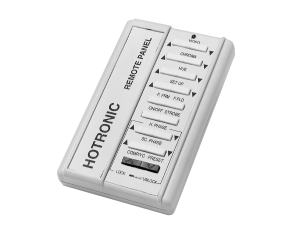
If you're saying to yourself at this
point, "hey I've seen one of those before" ... you are absolutely
right. On the surface at least, this control is identical to an X-10 HR12A PalmPad remote control.
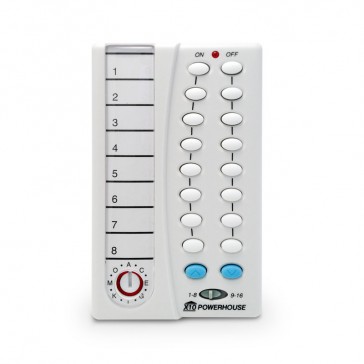
This produced a great deal of curiosity on my part. Why did Hotronic use this particular control? How
closely related is it to the X-10 HR12A? Could you use an HR12A, which
is probably much more commonly available and cheaper than the Hotronic
remote? I'd say there is a strong chance you might. What is inside the Hotronic remote panel?
I thought you'd never ask! (Any of these pictures can be clicked to see them larger.)
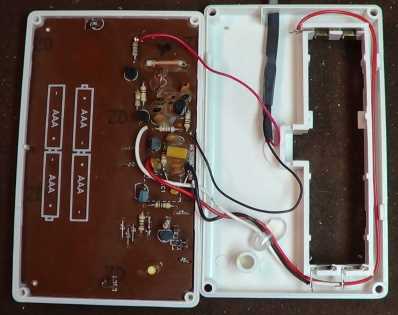
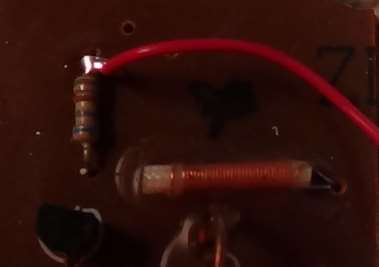
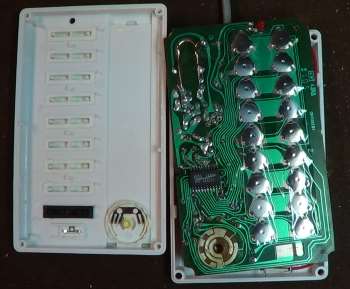

What's readily apparent here (besides
the generally very poor third world construction quality and soldering
job) is the fact that Hotronic's "remote panel" really is nothing more
than a reworked X-10 HR12A PalmPad remote control! Even the housecode
selection wheel is present! The lone IC is a Princeton Technology
Corporation PT2221, intended for use in infrared remote controls.
In case you're unfamiliar with the
X-10 wireless remote controls, they all work on the same general
principle: a signal in the 300 MHz radio band (the same band most
garage door opener remotes also use) is emitted by the remote and later
received by a "bridge" that decodes the transmitted signal and either
acts on it directly (if it is the device being addressed) or re-encodes
and passes it on down the power line to another X-10 device. My guess
is that the FCC would absolutely love the way this remote control was
modified -- it still appears to be perfectly capable of transmitting
signals and undoubtedly causing headaches for nearby owners of X-10
devices.
I can't readily swear to you that the
HR12A and Hotronic remote panel are precisely identical or that they
emit the same codes. It does, however, seem overwhelmingly likely that
such is the case given how little modification has been made. It's been
a very
long time since I've used any of my X-10 equipment and I don't know
that I could find one of the remote modules to verify my suspicions.
Unfortunately for those of you
without a remote panel, this state of affairs does complicate things
rather greatly. Even in this age of cheap and capable microcontrollers,
it's still not easy to encode and transmit a signal at several hundred
megahertz. On the other hand, the PT2221 IC might still be available
and figuring out what commands to send, and at what frequency to send
them, might not be too hard. Apart from the IC, the rest of the
circuitry is drop-dead simple. A more logical approach, and the one I'd
hoped to see in use here, was a simple resistance based switching
scheme, where different resistances would be connected in circuit and
the TBC card's microcontroller would decode them to determine which
function had been selected on the remote panel. Unless Hotronic really
got a screamin' deal on these things, the resistance based approach
seems like it would have been cheaper as well -- and there would have
been no need for batteries!
I'm not sure I have anything that I can use to observe the pulse trains emitted by this IC when various buttons are pressed.
Other Thoughts and Such
As one of my Hotronic TBC cards seems
not to work and the other is in as-yet unknown condition, I can't (yet)
speak to how well they work.
My experience with other broadcast grade
TBCs, which is admittedly very limited, has been extraordinarily
disappointing so far. The units I've found either haven't worked at
all, or haven't otherwise been effective at solving my problem. My
planned use was to clean up the synchronization and other timing
information in the signal coming from a PC video card's TV output. This
signal, which looked fine to a capture card and any other video device
I'd ever fed it into, was giving a Videonics MX-1 video mixer fits.
Sometimes those fits were severe enough to crash the Videonics MX-1.
This didn't initially seem like a difficult goal. Only later did it
turn into a severe case of rocket science. (I still cannot or at least
do not want to believe that grabbing a frame of video from a
potentially unstable source and flushing it out with newly rewritten
and precise synchronization and timing information is that difficult.)
Rather curiously, it seems that the
Videonics MX-1 (which is likely to get its own page at some point in
the future) does not perform any time base correction on its output unless it is presently performing a video effect, at which point it absolutely must do so.
All of this whole saga actually stems from my live streaming activities on the Internet. This isn't my first time going around and around
with something in an effort to try and make it work. If you're curious
about these shows, which aren't done very often at all, you may find
the FAQ page interesting.
Thus far, and to me at least, it
seems that the way to go if you're an end-user dealing with an unstable
video source that you need to quickly and easily fix without raising
your blood pressure, having a degree in broadcast engineering, being a
rocket scientist, dealing with companies that won't support their
products or perhaps all of those things, would be to use a MiniDV or
Digital8 Sony Handycam that features the ability to capture an analog
signal and digitize it over Firewire. Handycams with this function
present include a very effective TBC that really does Just Work. This
is what I ultimately did--chaining one such Handycam to another more
basic model (only one need have the ability to perform this realtime
analog conversion function) with a 4 pin DV to DV (or i.Link) cable.
Picking up the video from the second Handycam's S-video output and
feeding it to the MX-1 solved my problem without any of the
aforementioned rigamaroles
Sony doesn't sell new-model Handycams with this functionality present
any longer. You might find some on eBay or at other places where
secondhand goods are sold. A few models to look for include the
DCR-TRV22, 33, and 27 in the MiniDV format. Digital8 models with the
same capability include the DCR-TRV520, 460 and 480. This isn't a
complete list -- there are other Handycam models that have offered this
functionality as well. All of these camcorders have held a fair amount
of their value even on the secondhand market. Still, with some
persistence you can find a very good deal on one or two.
Go Back>
Copyright © 2015-2018 by William R.
Walsh. Some rights reserved. Your rights to reuse some or all of this
material in other projects are fully detailed at the "terms and
conditions" page available from the top level of this web server. In
simple terms, permission is granted to use portions or the entirety of
this page in your own projects, provided those projects do not contain
advertising materials and no fee other than that necessary to cover
reasonable duplicating or connection time expenses is charged. Such
projects must also not be of an illegal, derogatory, defamatory or
dangerous nature. Please don't parody my work even if the laws of your
country or locale allow you to do so. Thank you. Last updated 03/17/2018.

